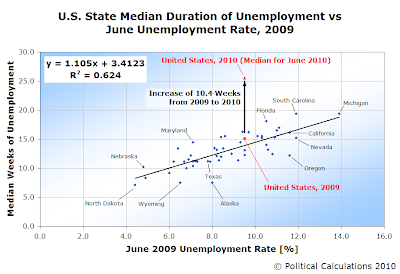 Missouri Unemployment Line What if you lost your job today and became unemployed? How long might it take you to find a new job?
Missouri Unemployment Line What if you lost your job today and became unemployed? How long might it take you to find a new job?
By and large, the answer to these questions depends specifically upon what kind of work you can do, but surprisingly, it also depends upon where you might work.
After all, if the unemployment rate in your state is high, then you can reasonably expect that it will take longer to find new work than would be the case if the unemployment rate in your state was low.
We took data presented by the left-leaning Economic Policy Institute's interactive map of median unemployment duration by state in 2009 and mashed up with the BLS' state unemployment rate data for June 2009 to create our first chart, which illustrates a pretty strong correlation between a state's unemployment rate and its median duration of unemployment. We also mapped out where the unemployment rate and median duration of unemployment for the entire United States was in 2009.
That last bit of information provides an important base reference point for comparing today's unemployment duration data with that of 2009. Using monthly U.S. median unemployment duration data collected by the St. Louis branch of the Federal Reserve, we can then take into account for the overall shift in the duration of unemployment that has taken place over the last year.

Meanwhile, we note that the U.S. has an identical rate of unemployment in June 2010 as it did in June 2009, and that many states have similar rates of unemployment as they did a year ago.
This last observation indicates that there is a severe shortage of jobs being created in the U.S. in 2010.
One way to think of the increase in the median duration of unemployment is like being in line at a supermarket that isn't adding enough cashiers to check out customers in a reasonable period of time in response to the demand for checking out groceries. The lines get longer and longer as customers queue up in them and they end up having to wait much longer in line just to be able to check out as a result.
By contrast, if the supermarket were adding cashiers in response to the demand for groceries, the wait time for customers would get shorter and shorter. The same scenario applies for the rate of job creation in the U.S. economy.
Going back to our original question, we now have enough information to develop a tool to approximate the median length of time it might take an average American to find a new job after becoming unemployed today, based on the current rate of unemployment in their state.
Just enter your state's latest unemployment data into the tool on the right and we'll run the numbers.
We'll close by emphasizing again that this data would apply for a generic American in 2010. Depending upon what work you specifically do, the amount of time you might reasonably expect to be unemployed can be very different from our projected median duration.
We should also caution you to be conservative - it may take much longer to find new work than our tool indicates. Our tool projects the median duration of unemployment, which means than although half of the unemployed will find new work in fewer weeks than what the tool indicates, half will take some weeks longer and in some states with high unemployment rates, there are individuals who have been unemployed for more than 99 weeks.
Welcome to the blogosphere's toolchest! Here, unlike other blogs dedicated to analyzing current events, we create easy-to-use, simple tools to do the math related to them so you can get in on the action too! If you would like to learn more about these tools, or if you would like to contribute ideas to develop for this blog, please e-mail us at:
ironman at politicalcalculations
Thanks in advance!
Closing values for previous trading day.
This site is primarily powered by:
CSS Validation
RSS Site Feed
JavaScript
The tools on this site are built using JavaScript. If you would like to learn more, one of the best free resources on the web is available at W3Schools.com.